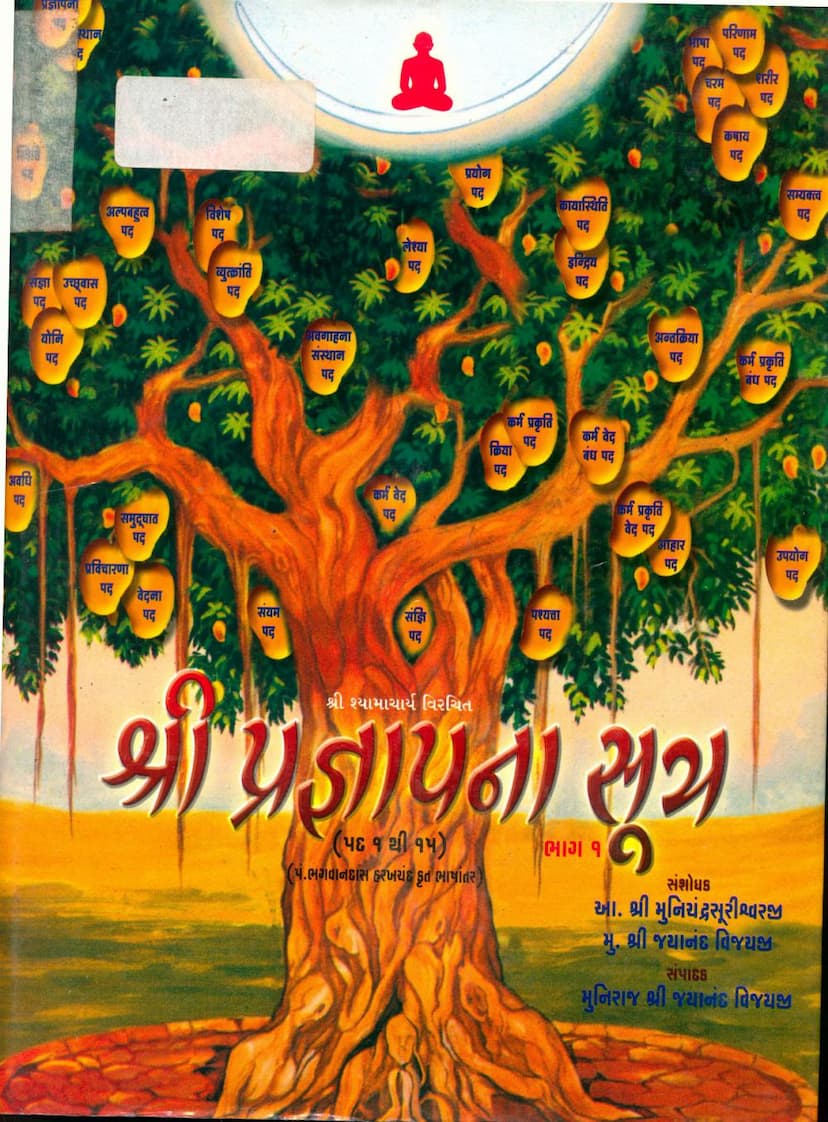Pragnapana Sutra Part 01
Added to library: September 2, 2025

Summary
Certainly! Here's a comprehensive summary of the provided Jain text, "Pragnapana Sutra Part 01," based on the pages you've shared:
Title: Pragnapana Sutra Part 01 Author(s): Munichandrasuri, Jayanandvijay (and originally compiled by Shyamacharya, with commentary by Malayagiri) Publisher: Guru Ramchandra Prakashan Samiti
Overall Summary:
The provided text is the first part of the Pragnapana Sutra, a significant Jain Agam (scripture) that belongs to the Upangas (subsidiary scriptures). This volume, specifically covering "Pad 1 to 15," focuses on the profound philosophical and cosmological concepts within Jainism, particularly from the perspective of Dravyanuyoga (the category of substance and reality). The text is presented in Gujarati, with the original Sanskrit texts and commentaries also referenced.
Key Aspects Highlighted in the Text:
-
Nature of the Text: The Pragnapana Sutra is described as the fourth Upanga and the largest among the 12 Upangas. It is also referred to as "Bhagavathi" and shares a similar question-and-answer style with the Bhagavati Sutra, featuring questions posed by Gautam Swami and answers given by Lord Mahavir. Its primary focus is Dravyanuyoga, emphasizing rational and accurate understanding of reality.
-
Authorship and Commentary: The original sutra is attributed to Aryashyamacharya, the 23rd successor of Lord Mahavir. The text includes a commentary (Tika) by Acharya Malayagiri, highly praised for its clarity and depth, making complex concepts accessible even to beginners. The current publication is a Gujarati translation and compilation based on scholarly efforts, including those of Pandit Bhagwandas Harakchand, Muni Shri Jayananvijayji, and others.
-
Content Overview (from the Index): The index and introductory sections reveal the vast scope of topics covered, which include:
- Prayog (Application/Use)
- Alpabahutva (Relative Quantity/Fewer-More discussion)
- Vishesh (Special attributes)
- Kayasthiti (Situation/State of the Body)
- Samayik Pad (Concepts related to Time)
- Leshya (Subtle karmic colors/dispositions)
- Indriya (Sense faculties)
- Sanjna (Consciousness/Perception)
- Uchchvas (Breathing)
- Vyukranti (Exhaustion/End)
- Pad (Concepts/Topics)
- Yoni (Origin/Source)
- Antakriya (End of action/life)
- Avagahana (Spatial extension/Size)
- Samsthana (Form/Configuration)
- Karma Prakriti (Types of Karma)
- Bandha Pad (Bonding of Karma)
- Karma Veda (Experience of Karma)
- Kriya Pad (Actions)
- Ahar (Nutrition/Ingestion)
- Upayog (Consciousness/Usage)
- Pravicharana (Wandering/Movement)
- Vedana (Sensation/Feeling)
- Sanyam (Restraint/Self-control)
- Pashyatta (Sight/Perception)
- Samudghat (Karmic emanation/expansion)
- Ayudha (Weapons/Tools - likely a karmic implication)
- Kashaya (Passions/Afflictions)
- Bodhi (Enlightenment)
- Dravya (Substance)
- Kshetra (Space/Region)
- Kaal (Time)
- Bhav (State/Disposition)
- Vachana (Speech/Language)
- Sharira (Body)
- Pudgala (Matter)
- Jiva (Soul/Living Being)
-
Comparison with Shatkhandagama: The text includes a detailed comparison between Pragnapana Sutra and the Shatkhandagama, another major Jain text, particularly from the Digambara tradition. Both originate from Drishtivada (one of the 14 Angas). Key differences highlighted are:
- Pragnapana focuses on the soul (Jiva) as the central theme, structured around 36 "Padas" (concepts).
- Shatkhandagama focuses on Karma, elaborating on concepts like Gunasthana (stages of spiritual progress) and karma categories.
- Pragnapana uses a question-answer style, often resembling dialogues between Lord Mahavir and Gautam Swami.
- Shatkhandagama follows a more academic structure of Uddesha-Nirdesha-Vibhaga (introduction, specification, classification).
- Pragnapana is considered earlier than Shatkhandagama, evidenced by Pragnapana's foundational establishment of Anuyogadwaras (methodological classifications) which Shatkhandagama utilizes more extensively.
-
Key Discussions (from the detailed section):
- Jiva and Ajiva: The fundamental Jain categories of soul and non-soul are elaborated upon.
- Padas/Topics: The text systematically discusses numerous topics, covering various aspects of Jain philosophy, including the different types of souls, their existence in different realms (lokas), their sensory capacities (Indriyas), lifespans (Ayushya), karmic dispositions (Leshya), passions (Kashaya), stages of spiritual progress (Gunasthana), consciousness (Upayog), nourishment (Ahar), language (Bhasha), and the nature of the body (Sharira).
- Embodiment and Soul: The concept of the soul's embodiment, its subtle and gross forms, and its journey through various Gatis (realms of existence) are discussed.
- Specific Categories: Detailed explanations are provided for categories such as Pudgala (matter) with its numerous qualities (color, smell, taste, touch, form), Dravya (substance), Kshetra (space), Kaal (time), and Bhav (state).
- Jiva and Ajiva in detail: The text delves into the classification of Jivas (souled beings) and Ajivas (soulless substances), breaking them down into numerous sub-categories based on various criteria like senses, lifespan, karmic inclinations, and qualities.
- Consciousness (Upayog) and Perception (Pashyatta): The text explores the nature and stages of consciousness, differentiating between Sakara (form-bound) and Anakara (formless) perception.
- Karma: The intricate workings of karma, including karma bondage (Bandha), karma types (Prakriti), and karma experience (Veda), are discussed in detail across several chapters.
- Moksha (Liberation): While not explicitly detailed in the provided fragments, the ultimate goal of liberation (Moksha) is implicitly the underlying theme of understanding reality and escaping the cycle of birth and death.
- The Term "Pragnapana": The title itself signifies profound knowledge or the act of making known, reflecting the text's purpose of elucidating complex philosophical truths.
- The Significance of "Bhagavati": The text highlights the title "Bhagavati" given to Pragnapana, indicating its supreme importance and comprehensive nature, comparable to the Bhagavati Sutra.
- The Concept of "Arya": A significant portion discusses the definition and classification of "Arya" (noble beings) based on geographic regions (Karmabhumi, Akarmabhumi), qualities, lineage, occupation, and knowledge.
-
Structure of Volume 1: This part specifically covers the first 15 "Padas" or concepts, indicating a systematic and structured approach to presenting Jain philosophy.
-
Relevance and Purpose: The publication and its translations are aimed at facilitating deeper understanding of Jain scripture, aiding scholars and practitioners in their quest for spiritual knowledge and self-realization.
This summary aims to capture the essence of the provided text, highlighting its foundational nature in Jain philosophy and the extensive, systematic manner in which it explores reality.